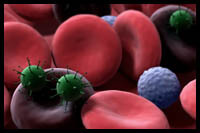 Neuroendocrinology Letters Volume 31 No. 3 2010
Neuroendocrinology Letters Volume 31 No. 3 2010
The role of environmental factors in autoimmune thyroiditis
Monika Hybenova, Pavlina Hrda, Jarmila Prochazkova, Vera Stejskal, Ivan Sterzl
ABSTRACT
Environmental factors can play an important role in the development of autoimmune thyroiditis (AT) and other autoimmune diseases. This article reviews the role of heavy metals and infectious agents in AT. Currently, the genes responsible for a metal-induced pathology are known in experimental animals but similar knowledge is lacking in man.
Metals such as nickel or mercury induce delayed type T cell hypersensitivity (allergy) which is relatively common, especially in women. T-cell allergy can be studied with the lymphocyte transformation test, LTT-MELISA®. It has been found that patients with AT and other autoimmune diseases, such as multiple sclerosis, psoriasis, systemic lupus erythematosus and atopic eczema, show increased lymphocyte reactivity in vitro to inorganic mercury, nickel and other metals compared to healthy controls.
The important source of mercury is dental amalgam. Replacement of amalgam in mercury-allergic subjects resulted in improvement of health in about 70% of patients. Several laboratory parameters such as mercury-specific lymphocyte responses in vitro and anti-thyroid autoantibodies were normalized as well. In contrast, no changes in health and laboratory results were observed in mercury-allergic patients who did not have their amalgams replaced. The same was true for non-allergic patients who underwent amalgam replacement.
Infectious agents such as Helicobacter pylori (Hp) may cause chronic inflammation and autoimmune reactivity in susceptible subjects. The results of in vitro experiments performed with lymphocytes from Hp infected patients indicate that Hp can cause immunosuppression which might be eliminated by successful eradication therapy.
In conclusion, heavy metals and Hp infection may play an important role in AT. Laboratory tests, such as LTT- MELISA®, can help to determine the specific etiological agents causing inflammation in individual patients. The treatment of AT and other autoimmune diseases might be improved if such agents are eliminated and any future exposure restricted.
INTRODUCTION:
Autoimmune thyroiditis (AT) is an organ-specific autoimmune disease and also the most frequently occurring autoimmune endocrinopathy. The etiology of autoimmune thyroiditis is multi-factorial. In addition to genetic predisposition, external factors such as physical and chemical influences as well as infectious agents can play an important role. A number of environmental factors have been postulated to be involved in the development of autoimmune thyroid diseases. This article will review the role of heavy metals and infectious agents.
In addition to the major form of AT, Hashimoto’s thyroiditis, juvenile, postpartum, silent, atrophic and fibrous thyroiditis have been described (Volpé 1988). AT is characterized by the loss of thyroid cells and gradual destruction of the gland due to lymphocyte infiltration, leading to thyroid hormone deficiency. Patients can have symptoms of hypothyroidism at the beginning, sometimes of hyperthyroidism or euthyroidism, nodular or diffuse goiter, and ultrasonographic hypoechogenity.
The presence of autoantibodies to thyroid peroxidase and thyroglobulin is an important diagnostic and predictive marker of the disease. Autoimmune reactivity can be caused by dysregulation due to imbalance of cytokines produced by Th1 and Th2 subtypes of lymphocytes. In Hashimoto thyroiditis, Th1 lymphocytes are predominantly stimulated and produce IL-2. IL-2 activates cytotoxic T cells which destroy target cells, thyrocytes (Volpé 1999).
Also, inadequate function of regulatory T cells contributes to autoimmunity (Chatila 2005). Another immunophathological mechanism involves antibodies against the TSH receptor. These antibodies are known to play a role in the development of another autoimmune thyroid disease, Graves’ thyrotoxicosis (Sterzl 2006).
AT can occur as an isolated form, or as a part of autoimmune polyglandular syndrome (APS) or polyglandular activation of autoimmunity (PAA). In PAA, antibodies against other endocrine organs such as adrenal and reproductive organs are present, often without clinical symptoms of organ damage (Muir et al. 1994; Laureti et al. 1998; Sterzl et al. 1998; 1999a; 2007).
CONCLUSION:
Environmental factors such as heavy metals and Hp play an important role in the etiology of AT and other autoimmune diseases. Memory T lymphocytes can be used as biomarkers of susceptibility to mercury and other inflammation triggers in individual patients.
If metal allergy is found, the patient should avoid all exposure to the allergenic substance. Mercury-allergic patients may benefit from replacement of dental amalgam. The treatment should be carried out in such a way as to minimize the exposure to mercury. Preliminary studies indicate that in some patients, Hp might cause immunosuppression which can be reversed by successful eradication therapy
